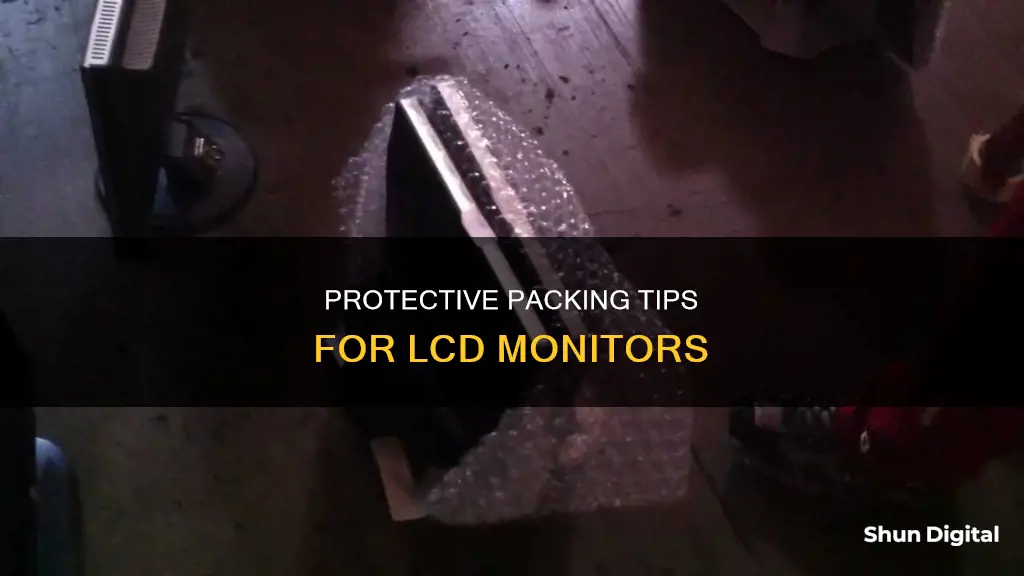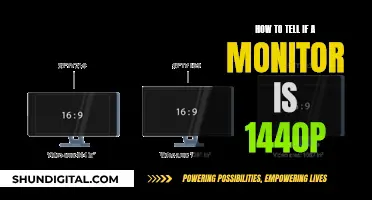
Packing an LCD monitor for travel or moving can be a daunting task. It is fragile, relatively large, and expensive, so it requires extra care and attention when transporting. The original box and packaging are ideal for this, but if you don't have them, there are other ways to pack your monitor safely. Here are some tips to ensure your LCD monitor arrives in one piece.
| Characteristics | Values |
|---|---|
| Original Box | Safest way to pack an LCD monitor |
| Bubble Wrap | Fill the bottom surface of the box with bubble wrap or packing paper for padding |
| Cardboard | Place cardboard snug against the front of the monitor |
| Cardboard Corners | Use cardboard corners to construct your own box |
| Shrink Wrap | Use shrink wrap or tape to ensure it fits snugly around the monitor |
| Packing Paper | Fill any empty space with packing paper |
| Fragile Sticker | Label the box with a "Fragile" sticker |
| Monitor Placement | Do not lay the box with the monitor face down, always make sure it is moved standing up |
What You'll Learn

Packing an LCD monitor for travel
Step 1: Check the Box
The first step is to locate the original box that your LCD monitor came in. The original packaging is specifically designed to protect your monitor during transport, so it is ideal for travel. If you still have the box, make sure it is in good condition and has all the necessary packing materials, such as foam or cardboard inserts.
Step 2: Measure Your Monitor
If you no longer have the original box, you will need to measure your LCD monitor to determine the size of the box you will need. Measure the width, height, and depth of your monitor. It is important to find a box that is not too big, as this can cause the monitor to shift during transport, but also not too small, as this can put pressure on the monitor and increase the risk of damage.
Step 3: Find the Right Box
When selecting a box for your LCD monitor, choose one that allows for packing material on all sides of the monitor. This will provide cushioning and protect your monitor from potential damage.
Step 4: Detach the Stand
If your LCD monitor has a detachable stand, it is recommended to remove it and pack it separately. This will reduce the weight and make it easier to secure the monitor in the box. It will also protect the stand from damage during transport.
Step 5: Protect the Screen
Use a piece of cardboard or thick cardboard slightly larger than the screen of your LCD monitor. Place it over the screen and secure it with tape. This will provide an extra layer of protection and prevent scratches or other damage to the delicate screen.
Step 6: Wrap Your Monitor
Wrap your LCD monitor in bubble wrap or similar protective material. Place the monitor on a flat surface, centre it on the bubble wrap, and then secure the bubble wrap around the monitor with clear packing tape. This will keep your monitor safe and prevent accidental damage during travel.
Step 7: Secure the Cables
Use clear packing tape to secure any loose wires or cables to the back of the monitor. This will prevent tangles and ensure that nothing gets pulled or damaged during transport. You can also use twist ties to keep the cables organised and tidy.
Step 8: Pack the Monitor in the Box
Place your wrapped monitor in the box, along with any necessary packing materials. If you are using the original box, this should be a perfect fit. If you are using a different box, make sure there is packing material on all sides of the monitor to prevent shifting.
Step 9: Seal and Label the Box
Once your monitor is securely packed, seal the box shut with tape. Be sure to use strong packing tape that will hold up during transport. Label the box with "Fragile" and "This Side Up" stickers to ensure that it is handled with care and placed in the correct orientation.
Step 10: Transport with Care
When travelling with your LCD monitor, be mindful of its presence and handle your luggage with care. Avoid placing heavy items on top of the box, and try to store it in a secure location where it won't be crushed or damaged.
By following these steps, you can confidently pack your LCD monitor for travel, ensuring its safety and security during your journey.
Asus Monitor Warranty: How Long Does It Last?
You may want to see also

Using the original box
If you still have the original box for your LCD monitor, you're in luck—packing your monitor will be a breeze. The original packaging was designed specifically for your monitor and will provide the best possible protection during transport. Here's a step-by-step guide on how to pack your LCD monitor using the original box:
Prepare the Box:
Start by inspecting the original box to ensure it's in good condition. Check for any tears or damage to the box's structure. If the box is intact, proceed to the next step.
Detach Accessories:
Most monitors come with a stand that can be detached. If your monitor stand is detachable, remove it and set it aside. You will pack it separately, which will make the monitor lighter and easier to handle.
Create a Protective Layer:
Using a screen measurement, cut out a piece of thick cardboard that will fit snugly over the front of the monitor. This extra layer will provide added protection for the delicate screen. You can tape this cardboard securely in place.
Wrap the Monitor:
Now, it's time to wrap the monitor in bubble wrap. Place the monitor on a flat surface and centre it on a slightly larger piece of bubble wrap. Use clear packing tape to secure the bubble wrap around the monitor, ensuring it is tightly wrapped. This protective layer will safeguard the monitor from scratches and accidental damage.
Secure the Cables:
Before placing the monitor in the box, address the cables. Detach any cables that can be removed and wrap them in plastic bags or the original packing material. You can also use clear packing tape to secure loose wires to the back of the monitor, preventing tangles and ensuring they stay with the monitor during transport.
Pack the Box:
With your monitor wrapped and cables secured, it's now time to place the monitor in the original box. Fill any remaining space in the box with packing material such as Styrofoam peanuts, bubble wrap, or crumpled-up paper. Ensure the box has enough padding on all sides of the monitor to prevent shifting during transport.
Seal and Label:
Once the monitor is securely packed in the box, seal it shut. Use packing tape to close the box and reinforce the seams. Don't forget to label the box with "Fragile" and "This Side Up" markings. This will indicate to handlers that the box contains delicate equipment and should be handled accordingly.
Transport and Store Correctly:
When transporting or storing the boxed monitor, always keep it in an upright position. Avoid laying the box face down, as this can put unnecessary stress on the monitor and increase the risk of damage.
By following these detailed steps, you can confidently pack your LCD monitor in its original box, ensuring its safety during transport or storage.
Power Cycling Your ASUS Monitor: A Simple Guide
You may want to see also

Preparing the monitor for packing
Unplug and Detach:
Start by unplugging all cables and cords connected to the monitor. Carefully disconnect everything, keeping the cords together to avoid tangling or misplacing them. Label the cords if needed to remember their correct placements. If your monitor has a detachable stand, remove it to make the monitor lighter and more compact for packing.
Clean the Screen:
Use a soft, dry cloth to gently wipe down the screen and remove any dust, fingerprints, or smudges. This step ensures that your monitor remains in good condition and prevents dirt from causing scratches during transportation.
Wrap the Monitor:
If you have the original box with custom foam inserts, place the monitor inside and secure it with the provided foam. If you don't have the original packaging, wrap the monitor generously in a soft material like a towel, bubble wrap, or foam sheets. Make sure the screen and all sides of the monitor are completely covered. Use packing tape to secure the wrapping, ensuring it doesn't come loose.
Secure Loose Items:
Use clear packing tape to secure any remaining loose wires to the back of the monitor. You can also use twist ties or elastic bands to keep the cables together and organised, preventing them from getting tangled or pulled during the move.
Cut Cardboard for the Screen:
Using the screen's measurements, cut out a piece of sturdy cardboard that will fit snugly over the front of the monitor. This extra layer will provide added protection for the delicate screen. Tape this cardboard in place to keep it secure.
Prepare the Box:
If you're using the original box, make sure it's in good condition. If you're using a different box, choose one that is slightly larger than the monitor to allow for extra padding. Line the bottom of the box with bubble wrap or packing paper to create a soft bed for the monitor to rest on.
Now that you've prepared the monitor and the box, you're ready for the next step—placing the monitor inside the box and sealing it securely.
Choosing the Right Monitor Size for Your Curve
You may want to see also

Packing the monitor in the box
Packing an LCD monitor can be a stressful task, but with careful planning and the right materials, it can be done securely. Here is a step-by-step guide to help you through the process of packing your LCD monitor in a box:
Preparing the Monitor:
First, gather all the necessary packing supplies. If you have the original box, fantastic! This will be the safest way to pack your monitor as it was designed specifically for your monitor and will provide the best protection. If not, don't worry. You will need a sturdy box that is slightly larger than the monitor, packing material such as bubble wrap, foam sheets, or packing paper, and packing tape.
Before you start wrapping your monitor, remove all cables and cords connected to it and keep them together so they don't get lost or tangled. Label the cords if that helps you remember where they go. Then, use a soft, dry cloth to gently clean the screen, removing any dust or fingerprints. This ensures that your monitor stays in good condition during the move.
Wrapping the Monitor:
If you have the original box with custom foam inserts, place the monitor inside and secure it with the foam. If you don't have the original box, wrap the monitor generously in a towel or protective wrap like bubble wrap, ensuring the screen is entirely covered. Use clear packing tape to secure the wrap around the monitor. Cut a piece of thicker cardboard that will fit over the front of the monitor, and tape it in place for added protection.
Packing the Box:
Now it's time to place the wrapped monitor into the box. If you're using the original box, simply fill any empty spaces with packing material like Styrofoam peanuts or crumpled-up paper. If you're using a different box, ensure there is packing material on all sides of the monitor to prevent shifting during transport. Place the monitor in an upright position in the box and seal it shut with packing tape.
Final Steps:
Once the monitor is securely packed, label the box with "Fragile" and "This Side Up" to ensure it is handled with care and isn't placed face down. If possible, place the box between softer items like pillows or blankets during transit to minimise the risk of damage. Now your LCD monitor is safely packed and ready for transport!
Scaling Virtual Machine Monitor Size: A Step-by-Step Guide
You may want to see also

Loading the monitor into the moving vehicle
When loading your LCD monitor into the moving vehicle, there are several important steps to follow to ensure its safety. Firstly, always place the box containing the monitor in an upright position. This is crucial, as laying the box face down can put stress on the monitor and increase the risk of breakage.
Next, ensure the box is secure and will not be crushed by heavier items. Place it between softer items, such as pillows, blankets, or other lightweight boxes. This will provide an extra layer of cushioning and safeguard the monitor from potential damage during the drive.
It is also important to avoid placing the monitor box near the edges of the vehicle, where it could be susceptible to shifting during the journey. If you are moving in a car, the back seat is an ideal location, as it is less prone to jostling. The key is to ensure the box remains stationary and secure throughout the trip.
If you are using a moving truck or van, follow similar principles by placing the monitor box in an upright position, away from the edges, and surrounded by softer items to prevent movement.
By following these steps, you can be confident that your LCD monitor will remain safe and protected during transit to your new home or office.
Unlocking Monitor Potential: Why is My ASUS Stuck at 60Hz?
You may want to see also
Frequently asked questions
If you have the original box, fill the bottom with bubble wrap or packing paper. Place bubble wrap over the screen and place a piece of cardboard snug against the front. If you don't have the original box, wrap the monitor in a towel or protective wrap and place it in a sturdy box with extra padding.
Yes, if the stand is detachable, remove it and pack it separately. This will make the monitor easier to pack and protect the stand from damage.
Gather the necessary packing supplies, such as bubble wrap, foam sheets, or packing paper, and a sturdy box. Remove any cables or cords and clean the screen with a soft, dry cloth. Wrap the monitor in a protective layer and fill any empty spaces with packing material. Place the box containing the monitor upright and ensure it is surrounded by softer items to prevent movement and minimise the risk of damage.
It is best to pack each monitor separately to ensure they are properly protected and do not damage each other.







